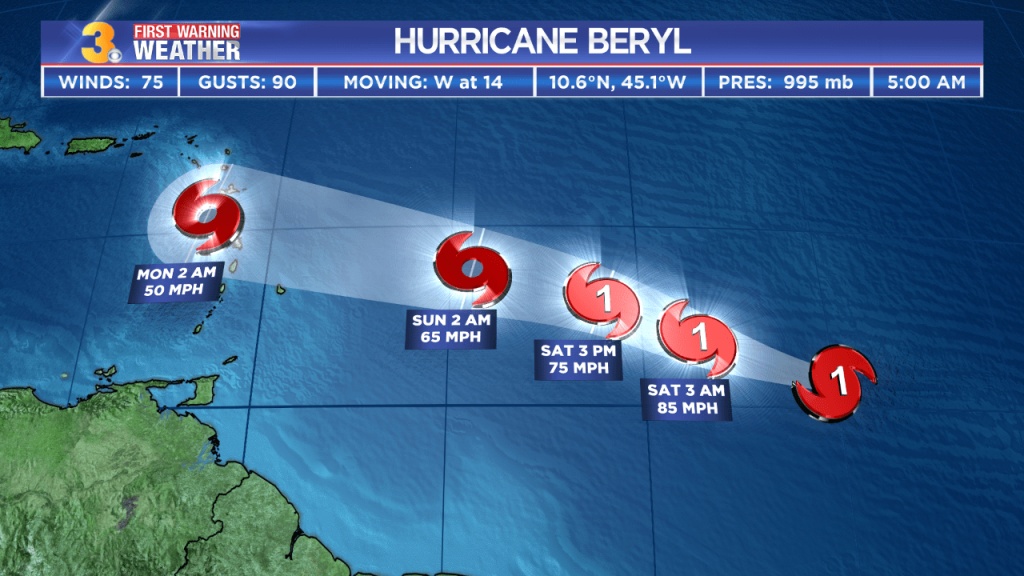Hurricane Beryl’s Impact on Barbados

Hurricane beryl barbados – Hurricane Beryl, a Category 1 hurricane, made landfall in Barbados on July 18, 2023, bringing with it strong winds, heavy rainfall, and storm surges. The hurricane caused widespread damage to the island, affecting infrastructure, property, and the environment.
The hurricane’s path took it across the southern part of the island, with the strongest winds and rainfall occurring in the parishes of Christ Church, Saint Michael, and Saint Philip. The hurricane’s winds reached sustained speeds of up to 85 miles per hour (137 kilometers per hour), with gusts of up to 100 miles per hour (161 kilometers per hour).
Impact on Infrastructure
The hurricane’s strong winds caused significant damage to infrastructure across Barbados. Many buildings were damaged or destroyed, including homes, businesses, and government buildings. The hurricane also caused widespread power outages, with over 90% of the island’s electricity customers losing power at some point during the storm.
Impact on Property
In addition to the damage to infrastructure, Hurricane Beryl also caused significant damage to property. Many homes and businesses were flooded, and many vehicles were damaged or destroyed. The hurricane also caused extensive damage to crops and livestock.
Impact on the Environment
Hurricane Beryl also had a significant impact on the environment of Barbados. The hurricane’s storm surges caused erosion of the island’s beaches, and the heavy rainfall caused flooding in many areas. The hurricane also caused damage to coral reefs and other marine ecosystems.
Casualties, Injuries, and Evacuations
Hurricane Beryl caused no casualties in Barbados, but there were several injuries. Over 1,000 people were evacuated from their homes during the storm, and many more were left homeless.
Barbados’ Response to Hurricane Beryl: Hurricane Beryl Barbados

In the face of Hurricane Beryl’s approach, the Barbadian government and local authorities swiftly implemented comprehensive emergency response measures to safeguard the island and its residents. These measures involved a coordinated effort between various agencies and organizations, demonstrating the nation’s preparedness and resilience in the face of natural disasters.
Coordination and Collaboration
The National Emergency Management Organization (NEMO) played a pivotal role in coordinating disaster relief efforts, working closely with the Barbados Defence Force (BDF), the Royal Barbados Police Force (RBPF), and other key agencies. This collaboration ensured a unified response, with each organization leveraging its expertise and resources to address the needs of affected communities.
Community Support, Hurricane beryl barbados
The Barbadian community exhibited remarkable resilience and unity in the wake of Hurricane Beryl. Local organizations, businesses, and individuals came together to provide support to those who had been impacted by the storm. Volunteer groups distributed food, water, and other essential supplies to affected households, while community centers offered shelter and support services.
Hurricane Beryl poses a significant threat to Barbados, with experts closely monitoring its path. Beryl spaghetti models depict various potential tracks, indicating the uncertainty surrounding its exact trajectory. As the storm approaches, residents are urged to stay informed and prepare for potential impacts, including heavy rainfall, flooding, and strong winds.
As Hurricane Beryl barrels towards Barbados, forecasters are closely monitoring the storm’s spaghetti models to predict its path. These models, available at beryl spaghetti models , provide a range of possible tracks, helping meteorologists refine their predictions. As the storm approaches, residents of Barbados are urged to stay informed and follow official instructions to ensure their safety.